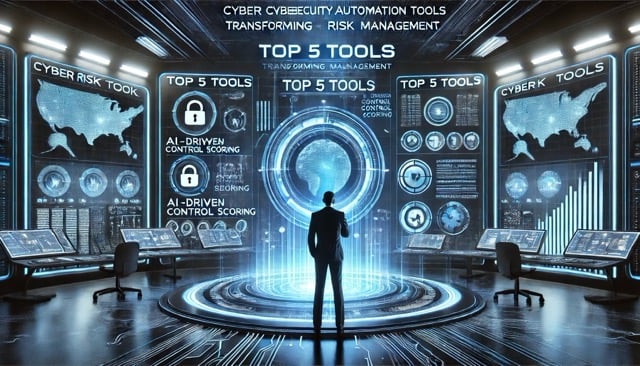For years, the discourse in IT has been centered around cybersecurity. Yet, with the volume of cyber attacks increasing, professionals have developed a more holistic approach to cybersecurity. This development has led to the creation of cyber risk management. You may be wondering whether the distinction between cyber risk management and cybersecurity is necessary, and the answer is yes. Cybersecurity and cyber risk management are related concepts, but they are not interchangeable. The main difference is the scope of these two concepts.
Cybersecurity v. Cyber Risk Management
Cybersecurity is the practice of protecting digital and IT assets, systems, and networks from cyber threats. This process includes implementing safeguards against unauthorized access, data breaches, attacks, and other cyber risks. Cybersecurity is focused on the technical measures and controls that are put in place to prevent, detect, and respond to cyber threats. It is often very technical and involves deploying several endpoint solutions. Examples include antivirus software, threat detection systems, firewalls, and cloud infrastructure protection.
The scope of cybersecurity is focused on the active protection of assets from threats. Cyber risk management is focused on taking a step back and assessing the strategies and operations that impact the organization and the existing security posture. Cyber risk management has been the answer security professionals have been searching for as cyber threats have grown and senior leadership has increased scrutiny of security operations.
Cybersecurity is a subset of cyber risk management. Cyber risk management includes cybersecurity as one of its components, but also considers the overall business risks related to cyber threats and develops strategies to manage those risks effectively. It's about aligning an organization's cyber defenses with its business objectives and risk tolerance.
Cyber risk management has a more holistic approach than cybersecurity's more technical and endpoint focus. Risk management involves understanding the potential impact of cyber threats on an organization's operations, reputation, financial stability, and compliance with regulations. This broader perspective includes technical safeguards, organizational policies, processes, employee training, compliance efforts, vendor assessments, and incident response planning.
By grounding cyber in a business context, CISOs and other security leaders can report to the Board and senior management on how security will impact the overall organization. An organization that does not consider cyber as a core part of the business is ill-prepared to defend against cyber threats, regardless of the number of endpoint solutions they’ve deployed.
Read more: Drive Cybersecurity Strategy with a CISO Dashboard.
There are several essential processes that security professionals need to consider when developing a cyber risk management plan. Keep reading to understand what you must do to establish your cybersecurity risk management plan.
The Essentials of a Cyber Risk Management Plan
While this list may seem extensive, there are no shortcuts for managing cyber security risks. Instead, security professionals should seek out automated platforms that help teams do more with their time and resources.
- Understand Your Organization’s Business Objectives and Risks:
- This step includes identifying your business’s goals, risks, and critical assets. Security teams should also identify existing security risks and potential security threats.
- Identification is crucial as this becomes the starting point for where cyber risk operations can grow and determines how much needs to be done and what needs protecting.
- Perform Cyber Risk Assessments:
- Conduct cyber security risk assessments to quantify potential impact and likelihood. Security and risk teams can leverage cyber risk quantification models like FAIR and NIST 800-30 to financialize cyber risk.
- Cyber risk quantification helps security teams prioritize risks based on their potential harm to the organization and the likelihood of occurrence. Threats that can cost the organization the most should be prioritized higher.
- Security practitioners must regularly perform cyber risk assessments to ensure that security teams make informed decisions based on current information.
- Define Your Organization’s Risk Tolerance:
- Along with quantifying cyber risk, your security teams must determine the organization’s risk tolerance. There can be a degree of risk that the organization can accept and afford. If the quantified risk is within a tolerable range, organizational leaders can accept it, further deprioritizing it in favor of risks that need more resources or attention.
- Align the risk tolerance with the organization's overall business goals.
- Develop Risk Mitigation Strategies:
- This step involves developing and implementing strategies to reduce the identified risks. These strategies may include implementing technical controls, process improvements, training, etc.
- Consider a multi-layered approach that addresses people, processes, and technology.
- Leverage risk remediation tools like CyberSaint’s Risk Remediation Suite to help security practitioners communicate and prioritize opportunities for risk reduction to senior leadership by addressing risk and control remediation in financial terms.
- Determine an Incident Response Plan:
- An organization should have a well-defined incident response plan in a cyber incident or data breach. This plan outlines the steps to take when an incident occurs, including containment, eradication of threats, recovery, and communication.
- NIST has developed best practices for developing an incident response plan that helps security teams structure a repeatable and coordinated process. This step ensures that all involved parties have defined roles and responsibilities and action items to refer to in the event of a breach.
- Testing and Simulation:
- Conduct tabletop exercises and simulations to test the incident response plan's effectiveness and identify areas for improvement.
- Continuous Monitoring:
- As mentioned earlier, cyber risk management is a holistic process, which means it’s also ongoing. Monitoring systems, networks, and control changes are crucial to detecting and responding to new threats and vulnerabilities. Security professionals should review previous incidents to identify weaknesses and what could have been done and implement such changes.
- In Gartner's Innovation Insight: Continuous Control Monitoring report, industry analysts broke down the critical capabilities of continuous solutions. See what industry experts have to say about CCM.
- Continuous monitoring applies to control monitoring and includes regularly reviewing and updating the cyber risk management plan based on new threats, changes in the business environment, and lessons learned from incidents.
- Employee Training and Awareness:
- Employees play a vital role in maintaining cybersecurity. Training and awareness programs help educate staff about best practices, threats and tactics to look out for, and proper handling of sensitive information.
- Organizations can develop weekly newsletters and offer training sessions and Q&As to keep employees updated.
- Vendor and Third-Party Risk Management:
- Cyber risk management includes more than managing organizations. Proper cyber risk management includes regular assessments of third-party vendors and partners to protect the organization and all related entities equally. Assessing these entities' cybersecurity posture is vital to ensure their practices align with the organization's security standards.
- Failure to consider the cyber risk posture of third-party organizations can lead to a domino effect if a cyber attack targets vendors or partners.
- CyberSaint has partnered with IBM Cloud Security and Compliance Center to streamline third and fourth-party risk management. Learn more about this strategic partnership.
- Communicating & Reporting to Senior Leadership:
- Board interest and scrutiny of cyber operations have skyrocketed as cybersecurity has become a business's core functioning. Senior management wants to know what is happening, what to invest in, and what can be done to continue improving and growing.
- CISOs, CIOs, and security leaders should leverage cybersecurity reporting tools to deliver data-backed and action-oriented cybersecurity reports relevant to business goals and operations.
- Establish clear communication channels for changes in security posture, remediation efforts, and compliance. Keep stakeholders informed about the organization's cybersecurity efforts and any changes to the plan. It’s critical to deliver reports based on the most current information; security leaders should utilize dashboards that are updated in real-time, like CyberStrong’s Executive Dashboard.
A Robust Cyber Risk Management Plan
Developing a cyber risk management plan that includes each listed process is vital to the success of your organization’s cyber and business operations. Based on your organization’s maturity, size, and resources, security teams must build their cyber operations to a point where all ten essentials are included.
Schedule a demo with our team to learn how CyberStrong, our all-in-one cyber risk management solution, can help your security team do more with less.





.png)
.png)
.png)
%201.png)
.png)




